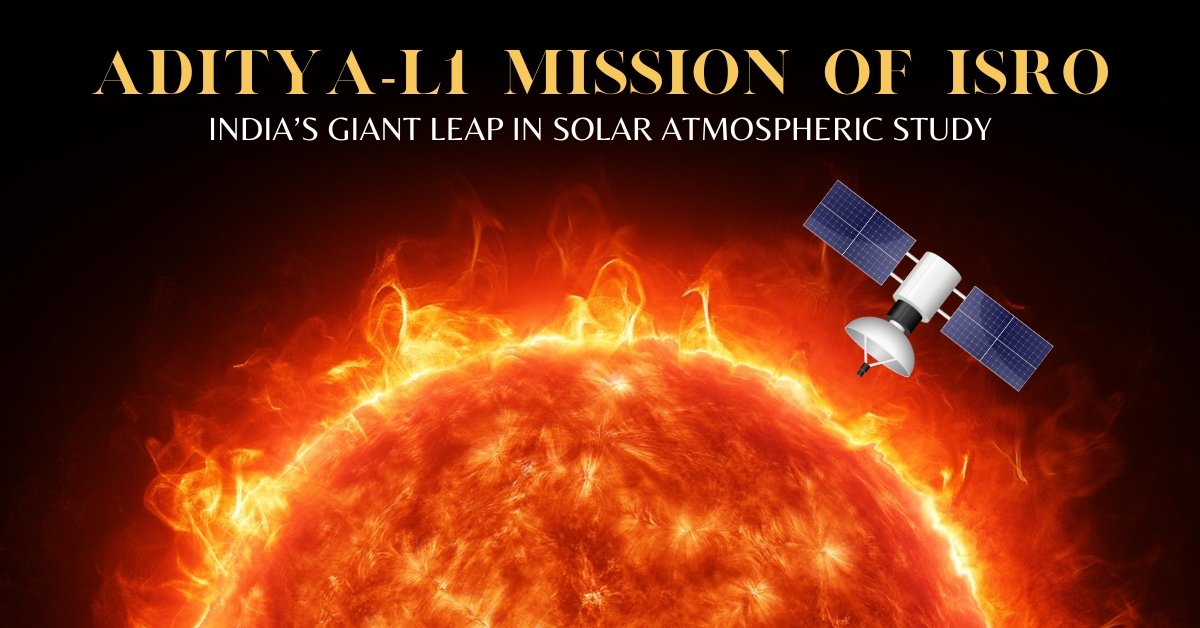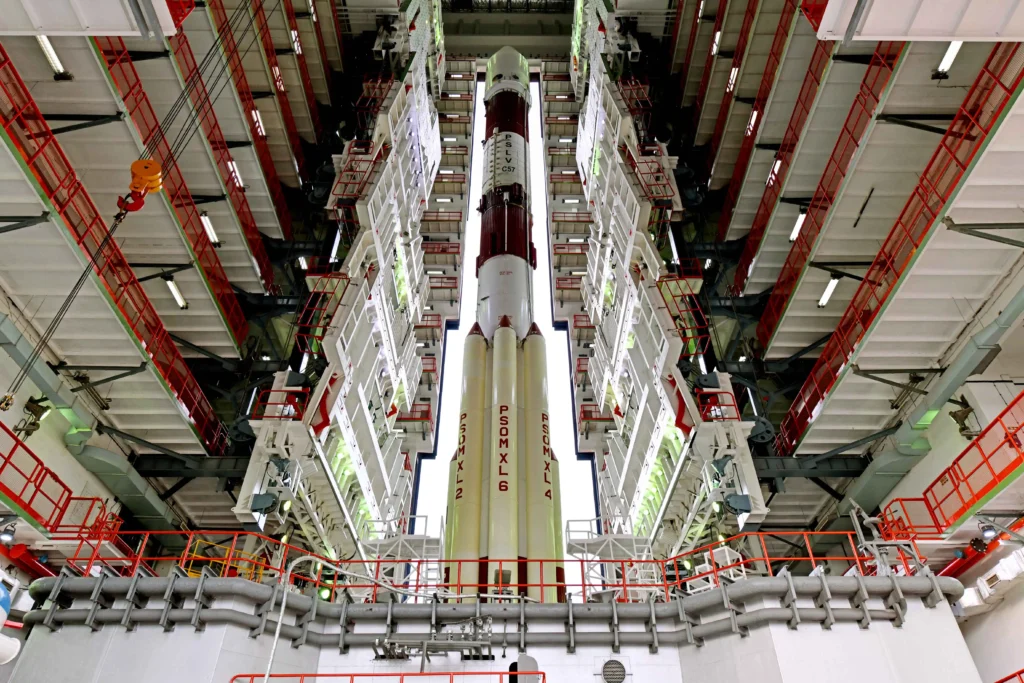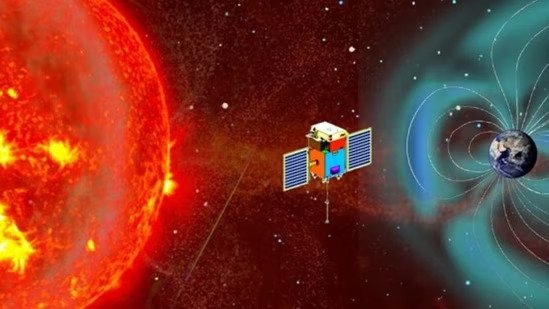The Indian Space Research Organisation (ISRO) has consistently pushed the boundaries of space exploration, and the Aditya-L1 mission is a shining example of this endeavor.
Aditya-L1 Mission is India’s first dedicated scientific mission to study the Sun. It aims to deepen our understanding of solar phenomena and their impact on the solar system, particularly on Earth. This article provides an in-depth look at the mission.
Introduction:
The Indian Space Research Organisation (ISRO) has consistently pushed the boundaries of space exploration, and the Aditya-L1 mission is a shining example of this endeavor. Aditya-L1 Mission is India’s first dedicated scientific mission to study the Sun. It aims to deepen our understanding of solar phenomena and their impact on the solar system, particularly Earth. This article provides an in-depth look at the mission.
The term “Aditya” in Sanskrit translates to “the Sun,” aptly naming ISRO’s mission focused on solar study. The “L1” in the mission’s name refers to the Lagrange Point 1 in the Sun-Earth system. This point is a specific location in space where the gravitational pull of the Sun and Earth balances each other. This equilibrium allows a spacecraft positioned at L1 to maintain a stable location relative to both the Sun and Earth, making it an ideal spot for continuous solar observation.
Objective of ADITYA-L1 MISSION:
The primary goal of the Aditya-L1 Mission is to study the solar corona, the outer layers of the Sun, which are hotter than its surface. Understanding these layers is crucial in predicting space weather events that can have significant effects on satellite communications, GPS systems, and power grids on Earth.
The main objectives of ADITYA-L1 mission can thus be pointed out as –
- Study of solar chromosphere and corona dynamics
- Study of chromospheric and coronal heating
- Study of physics of the partially ionized plasma
- Study of the initiation of the coronal mass ejections and flares
- Observe the insitu particle and plasma environment
- Diagnostics of the coronal and coronal loops plasma – temperature, velocity, and density
- Identify the sequence of processes that occur at multiple layers.
- Study of magnetic field topology and measurements in the solar corona.
- Understanding of dynamics of solar wind and drivers of space weather
Aditya-L1 Mission Design:
Since its inception in 2008, the Aditya-L1 Mission has evolved significantly. Initially planned as a modest 400-kilogram satellite in low-Earth orbit, it has expanded considerably over 15 years. The recently launched spacecraft now weighs nearly 1,500 kilograms and operates well beyond low-Earth orbit.
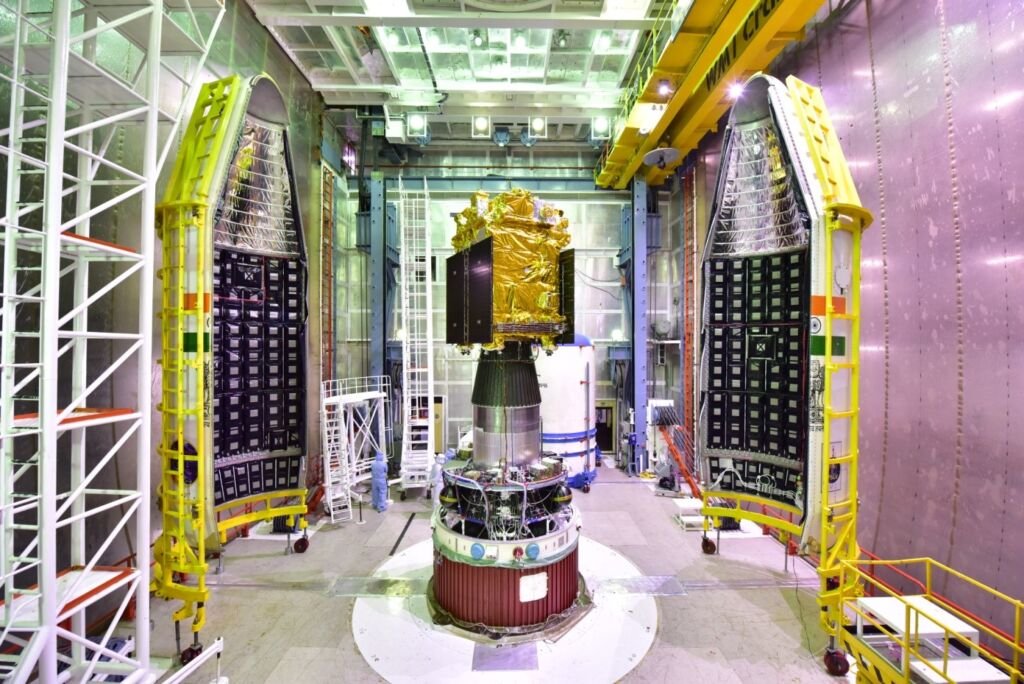
Aditya-L1’s design reflects ISRO’s innovative approach, featuring a cube shape with a honeycomb sandwich structure. It includes an integrated miniaturized GPS for real-time positional data and unfurls solar panels to power its lithium-ion battery, ensuring continuous operation.
Uniqueness of Aditya-L1:
- First-time spatially resolved solar disk in the near UV band
- CME dynamics close to the solar disk (~from1.05 solar radius) to provide information on the acceleration regime of CME
- Onboard intelligence to detect CMEs and solar flares for optimised observations and data volume
- Directional and energy anisotropy of solar wind using multi-direction observation
Budget of Aditya-L1:
The 2008-conceived Aditya Mission was repeatedly delayed due to a lack of funding. Initial plans for the mission in FY17 were for a modest, 400-kilogram low-Earth orbiting satellite to be used as an experimental project with a Rs 3 crore budget for studying the solar corona.
However, the price of the solar mission, minus launch costs, is Rs. 378.53 crore. The budget includes all research, development, and testing phases as well as the high-end equipment and expertise required for investigating the Sun’s corona.
Scientific Payloads:
The Aditya-L1 Mission payloads are expected to provide crucial information about the problems of coronal heating, coronal mass ejections, characteristics of pre-flares and flares, space weather dynamics, particle propagation, etc.
1. Visible Emission Line Coronagraph (VELC): This instrument aims to study the diagnostic parameters of solar corona and dynamics.
2. Solar Ultraviolet Imaging Telescope (SUIT): SUIT aims to observe the solar photosphere and chromosphere.
3. Aditya Solar Wind Particle Experiment (ASPEX):This experiment will study the particle flux emanating from the Sun. It will analyze Protons and heavier ions with directions.
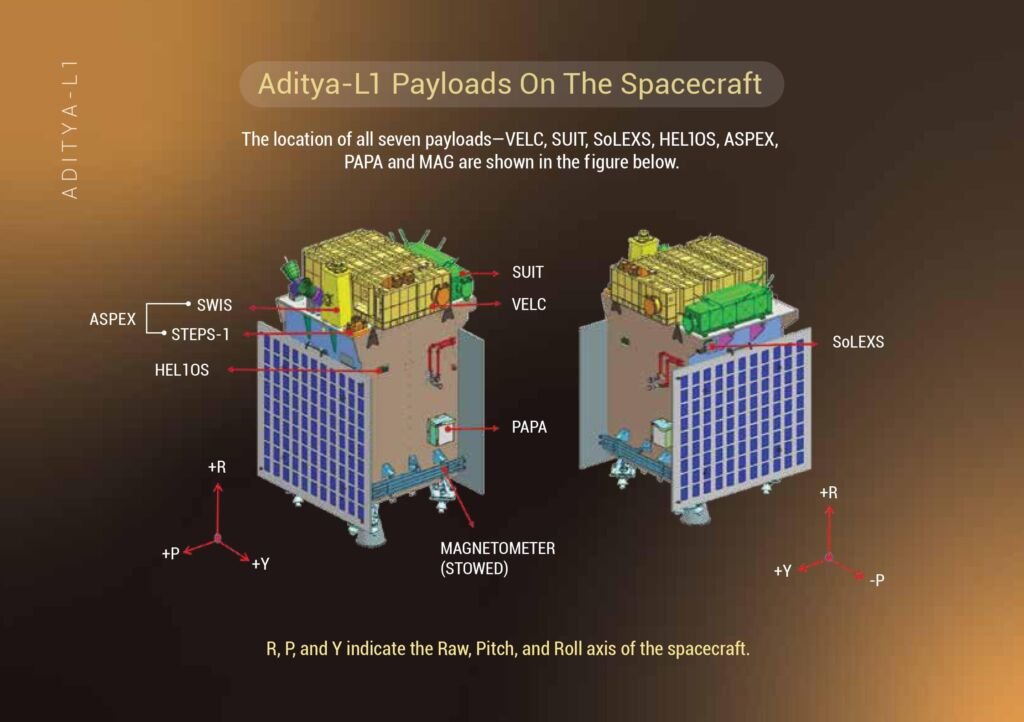
4. Plasma Analyser Package for Aditya (PAPA): Designed to understand the composition of solar wind and its distribution. It will analyze Electrons and heavier ions with directions.
5. Solar Low Energy X-ray Spectrometer (SoLEXS): It will measure the X-ray emissions from the solar flares.
6. High-Energy L1 Orbiting X-ray Spectrometer (HEL1OS): This will observe the X-ray emissions from the solar corona.
7. Advanced Tri-axial High-Resolution Digital Magnetometer (MAG): To measure the magnitude and nature of the interplanetary magnetic field.
Collaborators for Aditya-L1 Mission:
Aditya L1, the first solar mission of ISRO is a collective effort of various space tech organizations. It is a collaboration of ISRO with 6 other institutes.
IIA – The Indian Institute of Astrophysics (IIA) has played an important role in Aditya L-1 Mission.
DST – Department of Science and Technology is behind the ‘suitable coronograph’ payload mounted on Aditya-L1.
ESA – The European Space Agency (ESA)is contributing to ISRO’s Aditya-L1 mission in two significant ways.
- Firstly, ESA is offering deep space communication services for the mission, ensuring reliable data transmission.
- Secondly, last year, ESA played a crucial role in assisting ISRO with the validation of new flight dynamics software, a key component for the mission’s navigation and control.
This collaboration underscores the international cooperation in space exploration and research.
Launch Details:
The Aditya-L1 Mission, ISRO’s first space-based observatory-class solar mission, was launched on September 2, 2023, aboard the Polar Satellite Launch Vehicle (PSLV-C57). It is dedicated to a comprehensive study of the Sun and is set to arrive at the Lagrange Point 1 (L1) on January 6, 2024.
Located about 1.5 million km from Earth, this position provides a unique vantage point for solar observation. The spacecraft performed a “Trans-Lagrangian1 insertion manoeuvre” marking the start of its 110-day trajectory to the L1 point. Aditya-L1 is planned to stay in a halo orbit around L1 for the next five years, gathering crucial data for understanding solar dynamics and their impact on Earth.
PSLV-C57/ Aditya-L1 Mission:
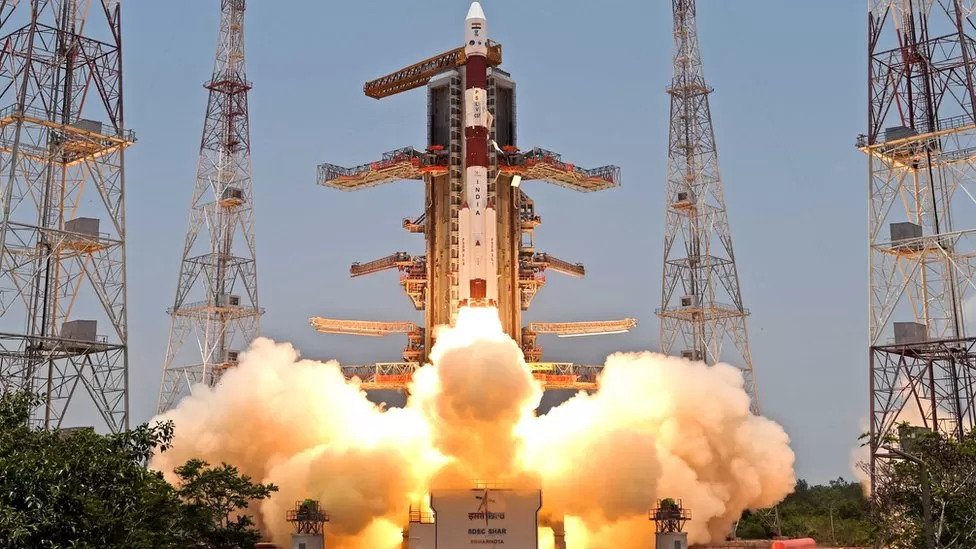
- September 2, 2023: ISRO’s Aditya-L1, India’s first solar observatory made its successful launch by PSLV-C57 from the Satish Dhawan Space Centre at Sriharikota Island.
- September 3, 2023: The first Earth-bound maneuvre (EBN#1) was successfully performed from ISTRAC, Bengaluru.
- September 5, 2023: The second Earth-bound maneuvre (EBN#2) was successfully performed.
- September 10, 2023: The third Earth-bound maneuvre (EBN#3) was successfully performed.
- September 15, 2023: The fourth Earth-bound maneuvre (EBN#4) was successfully performed.
- September 18, 2023: Aditya-L1 started collecting scientific data.
- September 30, 2023: Aditya-L1 escaped the sphere of Earth’s influence on its way to the Sun-Earth Lagrange Point 1 (L1)
- October 8, 2023: A Trajectory Correction Maneuvre (TCM) was performed.
- November 7, 2023: HEL1OS captured the first High-Energy X-ray glimpses of solar flares.
- December 1, 2023: The Solar Wind Ion Spectrometer (SWIS) in the ASPEX was made operational.
- December 8, 2023: SUIT captured full-disk solar images in near ultraviolet wavelengths.
- January 6, 2024: Aditya-L1 solar observatory was successfully inserted into Halo-Orbit around Sun-Earth L1.
Significance of ISRO’s Aditya-L1 Mission:
This Mission, spearheaded by the Indian Space Research Organisation (ISRO), is not just a scientific endeavor but a landmark in understanding solar phenomena. The significance of this mission can be broadly categorized into several key areas:
1. Advancement in Solar Science:
- Unraveling Solar Mysteries: The mission’s focus on studying the solar corona is crucial. Despite being the outermost layer of the Sun, the corona is hotter than its surface, a phenomenon that continues to puzzle scientists. Aditya-L1’s investigations could provide answers to this long-standing mystery.
- Understanding Solar Flares and Coronal Mass Ejections: These solar events can release vast amounts of energy and particles, which can impact space weather. By studying these phenomena, the mission will contribute to our understanding of the Sun’s behavior and its impact on the solar system.
2. Impact on Space Weather Forecasting:
Predicting Geomagnetic Storms: The data obtained from Aditya-L1 will aid in predicting geomagnetic storms caused by solar activities, which can disrupt satellite operations, GPS navigation, power grids, and even aviation communications on Earth.
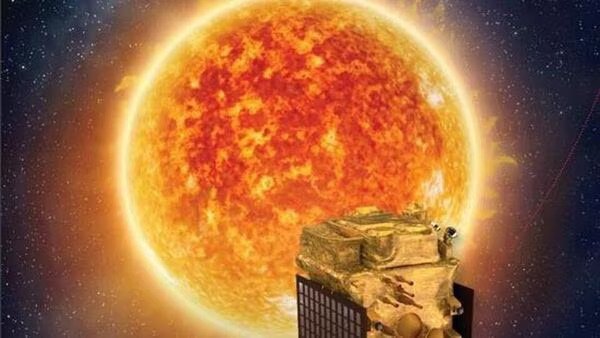
Enhancing Satellite Safety: Understanding space weather is vital for the operation of satellites, particularly those in geostationary orbits. The findings of Aditya-L1 Mission will help in devising better strategies to protect satellites from solar radiation and particles.
3. Technological Achievements:
Innovative Instrumentation: The mission employs a suite of sophisticated instruments, each designed to withstand harsh solar radiation and provide precise data. These technological advancements will not only serve the mission but also enhance ISRO’s capabilities in spacecraft instrumentation.
Orbital Dynamics and Navigation: The challenge of maintaining a stable orbit around the L1 point, a region in space where the gravitational forces of the Earth and Sun balance, showcases ISRO’s growing prowess in complex space navigation and engineering.
4. Global Scientific Collaboration:
International Partnerships: Aditya-L1 sets a platform for international collaboration in space research. By sharing data and insights with global scientific communities, ISRO contributes to a collective understanding of solar dynamics.
Educational and Inspirational Impact:The Aditya-L1 Mission inspires future generations of scientists and engineers, showcasing the importance of space research and exploration.
5. National Pride and Global Standing:
Boosting India’s Space Program: Aditya-L1 is a testament to India’s growing capabilities in space exploration and research, placing it among the leading nations in space science.
Economic and Strategic Benefits: The technological advancements and scientific discoveries from the mission have potential long-term economic benefits, particularly in areas related to space weather impacts and satellite technology.
6. Paving the Way for Future Missions:
Foundation for Future Research: The success of Aditya-L1Mission will pave the way for more ambitious missions, including those targeting other planets and celestial bodies. It will also provide valuable lessons for future solar missions.
7. Enhancing Understanding of Earth-Sun Relationship:
Climate Studies: The mission will contribute to our understanding of how solar variability impacts Earth’s climate, an area of significant importance given the current focus on climate change and its global effects.
ISRO’s Aditya-L1 Mission holds immense significance in the realms of scientific discovery, technological advancement, international collaboration, and national pride. It marks a significant milestone in humanity’s quest to understand the Sun and its influence on the solar system, particularly Earth.
The mission’s success will undoubtedly have far-reaching impacts, contributing to our knowledge and preparation for space weather phenomena and enhancing our capabilities in space exploration.
Challenges for Aditya-L1 Mission:
- Unique Halo Orbit: Once Aditya-L1 is placed in the halo orbit, it faces unique challenges due to the complex 3D nature of this orbit. Unlike typical orbits, the halo orbit is highly convoluted as it revolves around the dynamically moving L1 point, which is itself in motion along the earth-sun line. This adds complexity as Aditya orbits a point that is not stationary but shifts with Earth’s movement around the sun.
- Unstable Equilibrium of L1 point: The Lagrange Point 1 (L1) represents a point of unstable equilibrium, similar to balancing at the top of a hill where even a slight disturbance can initiate movement. Due to this inherent instability, it’s crucial to continuously monitor and adjust the spacecraft’s position. The thrusters of Aditya-L1 play a vital role in this process, actively maintaining the spacecraft’s orientation and control within the halo orbit, ensuring it remains precisely within its designated trajectory.
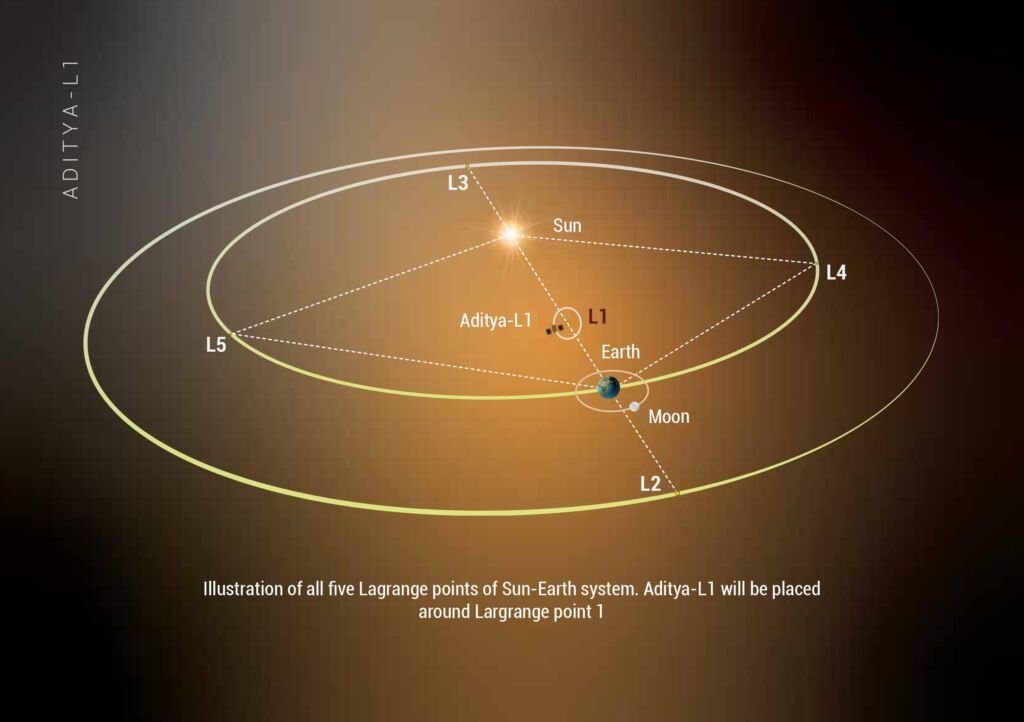
- Collision Avoidance: Avoiding collisions is a critical challenge for Aditya-L1 in its orbit. The spacecraft must carefully navigate to avoid any possible collisions with other missions or objects in space. This task demands precise planning and execution, underscoring the complexity and precision required in the field of orbital dynamics. Aditya-L1’s successful navigation in this intricate space environment is crucial for the mission’s success.
- Collision Avoidance: Avoiding collisions is a critical challenge for Aditya-L1 in its orbit. The spacecraft must carefully navigate to avoid any possible collisions with other missions or objects in space. This task demands precise planning and execution, underscoring the complexity and precision required in the field of orbital dynamics. Aditya-L1’s successful navigation in this intricate space environment is crucial for the mission’s success.
- No Landing Ground: Positioned about 1.5 million kilometers away from Earth, Aditya-L1 is directed towards the Sun, a distance that represents roughly 1% of the Earth-Sun separation. The mission’s primary focus is on studying the Sun’s outer atmosphere. Aditya-L1 is designed for observation only; it will neither land on the Sun nor venture closer to it during its mission.
Conclusion:
ISRO’s Aditya-L1 Mission is not just a milestone for Indian space research but also a significant step forward in our quest to understand the Sun. The mission’s success will propel further explorations and deepen our knowledge of the universe.

